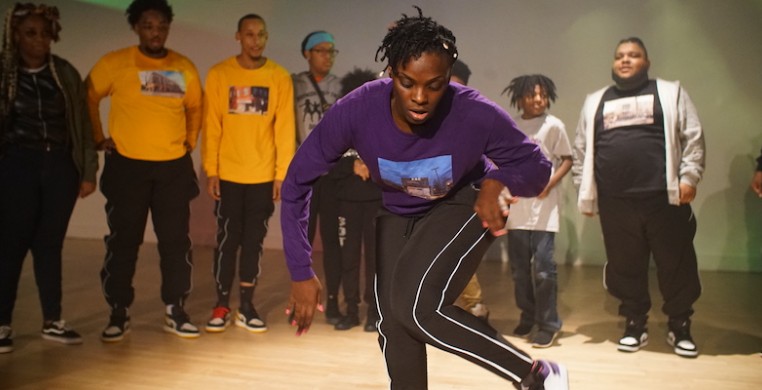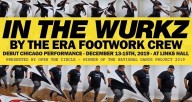The dancers entered Links Hall’s Studio A—the white space—in socks. They put on gym shoes and danced for an hour, and then took them off again, leaving the room how they came.
That’s not the only thing that made the North Side premiere of The Era’s “In the Wurkz” a little different from much of Links Hall’s programming, but it’s the one that struck me the most. Attending Friday, the room was a bit disorienting as the crowd—one far too big for the space—filed in for “In the Wurkz,” a restaging of the performance Jamal “Litebulb” Oliver and his footworking crew called The Era first premiered in 2016. Oliver was the first street dance choreographer to receive the prestigious Chicago Dancemakers Forum grant, a prize which supports a year-long creative process and development of new works. “In the Wurkz” continues to morph and change, with this presentation presumably kicking off a touring initiative supported by a National Dance Project grant.
Since 2016, The Era has regularly been seen throughout the city, particularly at the downtown dance festivals produced by the Department of Cultural Affairs and Special Events. Rightly so: Footworking is an awe-inspiring and fantastically entertaining dance style to watch, a home-grown street dance form which first began on the West Side and spread South, before making its way to the North Side.
But rarely at Links Hall, hallowed grounds for barefoot dancing and experimental performance. Footworking exists in clubs and alleys, with dance battles taking place within a circle, an intoxicating huddle of bodies totally lost in the moment. Contrast that with the transactional nature of concert dance—you dance, we watch. “In the Wurkz” brought a bit of the circle into an otherwise sterile space through dizzying projections on three sides, the squeak of shoes against Links’ maple floors, pedestrian costumes, and even the oversold room. It doesn’t feel particularly new or mind-blowing in its choreographic construction. But “In the Wurkz” is ground breaking in many ways, and it's the juxtaposition of two very different dance environments which most compels me about this piece.
For what felt like a long time, the audience buzzed with conversational chatter as projections on three walls repeat in a loop. Mostly, the video consisted of a person dancing, shown from the knees down, in an anonymous alleyway. With the scraping sounds of feet against asphalt, the picture multiplies and reduces, a mesmerizing meditation which serves, for some, as an introduction to footworking. It could have been anywhere, I guess, but instantly feels like Chicago.
Fourteen scenes unfold once the dancers come out and put on their shoes, a mix of fast-paced dancing, rapping or the recitation of poems interpreted through the body, and video. There’s so much Chicago in “In the Wurkz:” images of “L” tracks and familiar spaces downtown; to the origin story of footwork in predominantly low-income, black neighborhoods far away from those tourist spaces; to stories of resilience, poverty, and interactions with police. In a section called “Ladies’ Thoughts,” The Era’s two women, Elisha “Eleelee” Chandler and Diamond “Queen Diamond” Hardiman, talk about why and for whom they dance (Spoiler: it’s not for the men), and what it’s like to be a woman in a male-dominated dance form. And all this is captured in a tantalizing blend of swagger and nonchalance.
“In the Wurkz” is an exceptional example of what can happen when street dance and concert dance coalesce. And Links Hall felt electrified, teeming with snaps, claps and other signals of solidarity, as though we all get it. Maybe some of us do. But “In the Wurkz” conveys a particular version of Chicago that many Links Hall patrons will never experience. Dancer Brandon Calhoun states that uncomfortable truth right off the bat: “White walls, white people, wishing they could relate,” is among the first lines of the show.
To be clear, the audience was not entirely white. And while Links Hall is a historically white space—literally and figuratively—they’ve made conscious efforts to be more welcoming to artists of color. Still, I can’t help but feel that The Era is rightfully questioning the motivations of the audience, or at least reminding us that footworking belongs to them.



